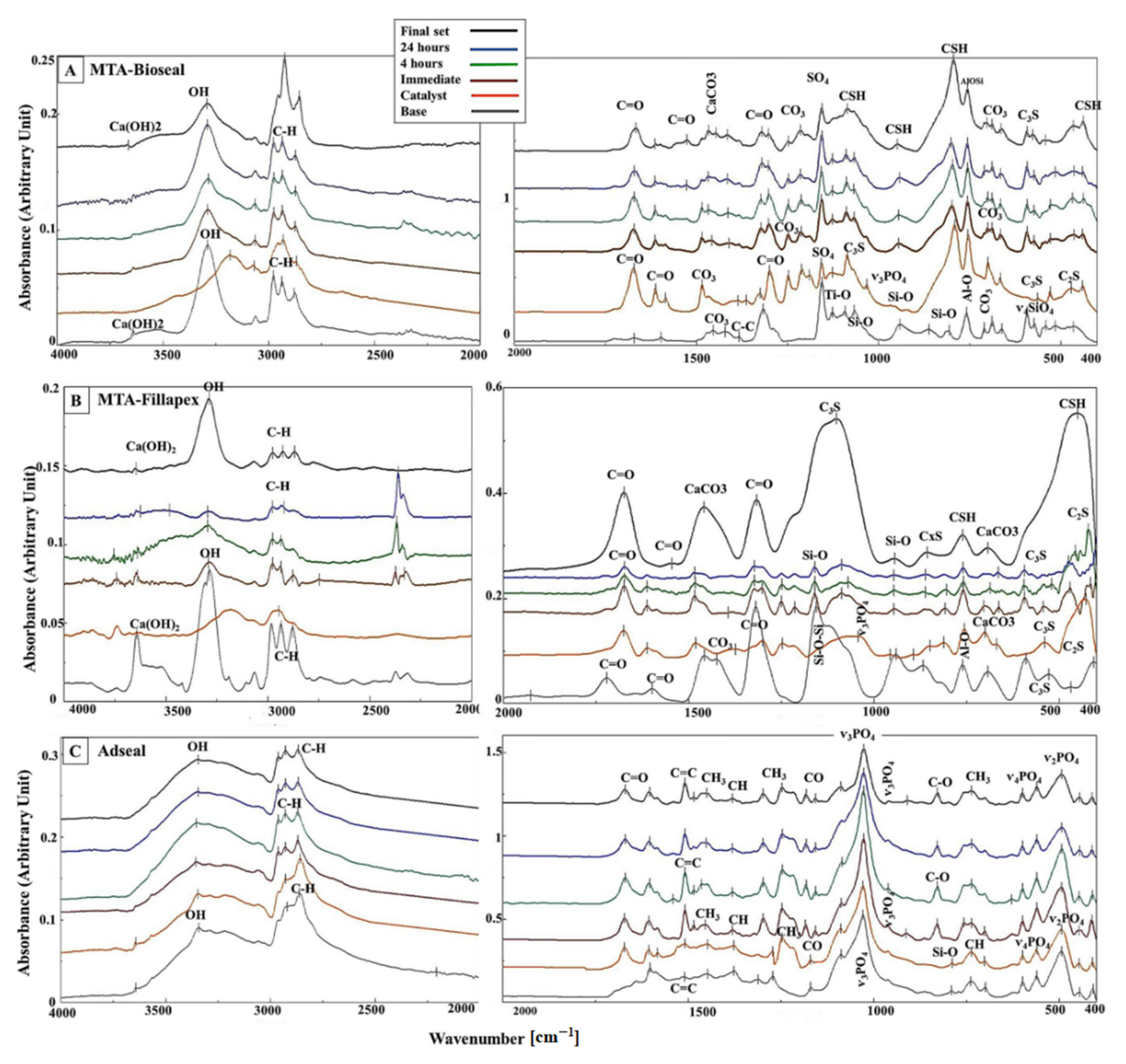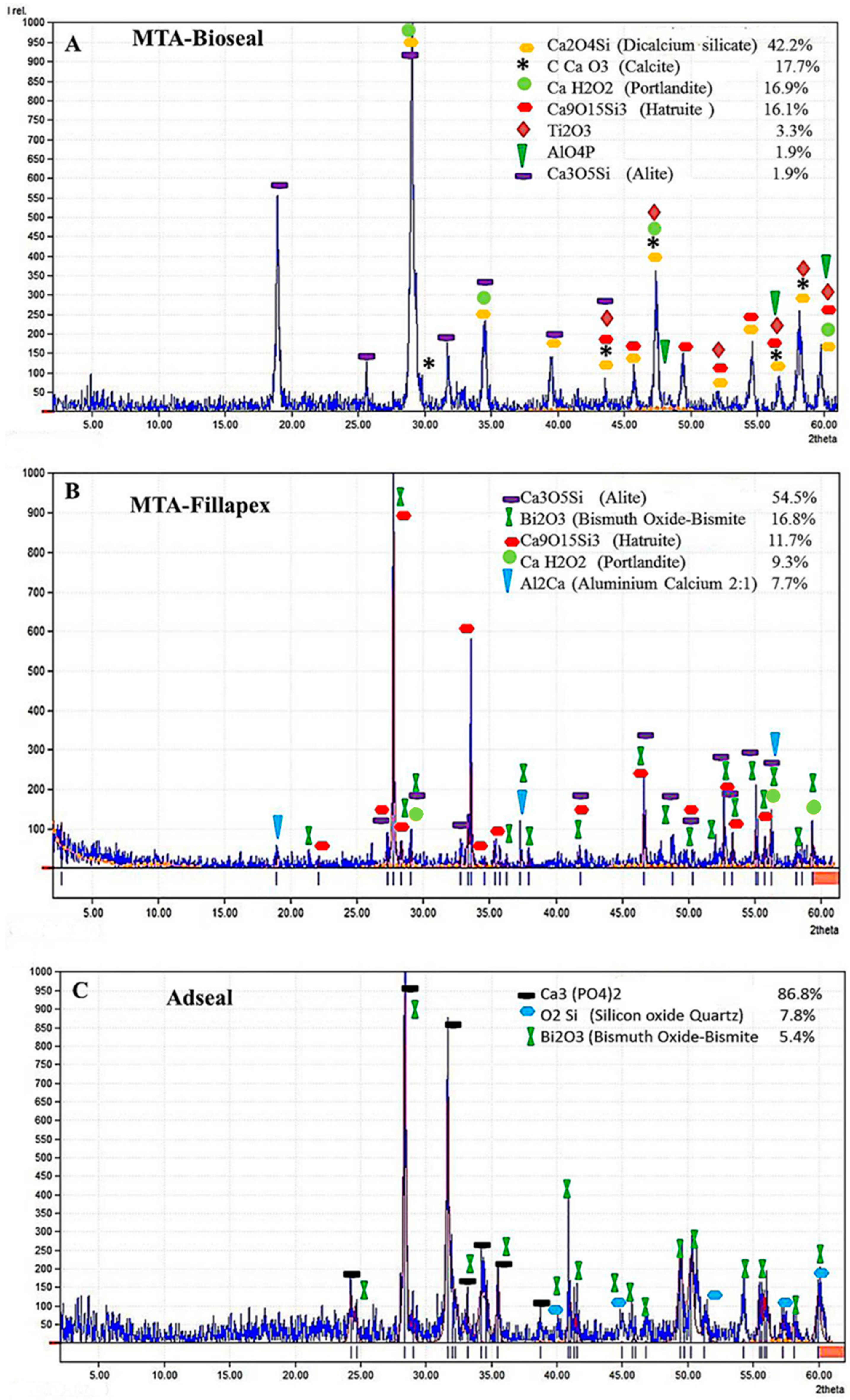Hydration Characterization of Two Generations of MTA-Based Root Canal Sealers
Abstract
:1. Introduction
2. Materials and Methods
2.1. Setting Time
2.2. Setting Reaction Based on Fourier Transform Infrared (FTIR) Spectroscopy
2.3. Phase Analysis by X-ray Diffraction (XRD)
2.4. Statistical Analysis
3. Results
3.1. Setting Time
3.2. Setting Reaction by FTIR
3.3. Phase Composition Determined by X-ray Diffraction (XRD) Analysis
4. Discussion
5. Conclusions
Author Contributions
Funding
Institutional Review Board Statement
Informed Consent Statement
Data Availability Statement
Conflicts of Interest
References
- Ørstavik, D. Materials used for root canal obturation: Technical, biological and clinical testing. Endod. Top. 2005, 12, 25–38. [Google Scholar] [CrossRef]
- Grossman, L.I. Endodontic Practice, 11th ed.; Lea & Febiger: Philadelphia, PA, USA, 1988; pp. 326–327. [Google Scholar]
- Torabinejad, M.; Hong, C.; McDonald, F.; Ford, T.P. Physical and chemical properties of a new root-end filling material. J. Endod. 1995, 21, 349–353. [Google Scholar] [CrossRef]
- Darvell, B.; Wu, R. “MTA”—An hydraulic silicate cement: Review update and setting reaction. Dent. Mater. 2011, 27, 407–422. [Google Scholar] [CrossRef] [PubMed]
- Parirokh, M.; Torabinejad, M. Mineral trioxide aggregate: A comprehensive literature review-part I: Chemical, physical, and antibacterial properties. J. Endod. 2010, 36, 16–27. [Google Scholar] [CrossRef]
- Camilleri, J.; Formosa, L.; Damidot, D. The setting characteristics of MTA Plus in different environmental conditions. Int. Endod. J. 2013, 46, 831–840. [Google Scholar] [CrossRef]
- Holland, R.; Gomes, J.E.; Cintra, L.T.A.; Queiroz, Í.O.D.A.; Estrela, C. Factors affecting the periapical healing process of endodonti-cally treated teeth. J. Appl. Oral Sci. 2017, 25, 465–476. [Google Scholar] [CrossRef] [Green Version]
- Azar, N.G.; Heidari, M.; Bahrami, Z.S.; Shokri, F. In vitro cytotoxicity of a new epoxy resin root canal sealer. J. Endod. 2000, 26, 462–465. [Google Scholar] [CrossRef]
- Grossman, L.I. Physical properties of root canal cements. J. Endod. 1976, 2, 166–175. [Google Scholar] [CrossRef]
- Angulus Science and Technology. MTA-Fillapex Endodontic Sealer, Scientific Profile. 2011. Available online: http://www.angelusdental.com/img/arquivos/mta_fillapex_technical_profile_download.pdf (accessed on 22 August 2021).
- Benezra, M.K.; Wismayer, P.S.; Camilleri, J. Influence of environment on testing of hydraulic sealers. Sci. Rep. 2017, 7, 17927. [Google Scholar]
- Loushine, B.A.; Bryan, T.E.; Looney, S.W.; Gillen, B.M.; Loushine, R.J.; Weller, R.N.; Pashley, D.H.; Tay, F.R. Setting properties and cytotoxicity evaluation of a premixed bioceramic root canal sealer. J. Endod. 2011, 37, 673–677. [Google Scholar] [CrossRef]
- Lee, J.K.; Kwak, S.W.; Ha, J.-H.; Lee, W.; Kim, H.-C. Physicochemical properties of epoxy resin-based and bioceramic-based root canal sealers. Bioinorg. Chem. Appl. 2017, 2017, 2582849. [Google Scholar] [CrossRef] [PubMed] [Green Version]
- ITENA Clinical Product. MTA-Bioseal, White Paper—Dental Sky. 2018. Available online: https://www.dentalsky.com (accessed on 20 August 2021).
- Zhou, H.-M.; Shen, Y.; Zheng, W.; Li, L.; Zheng, Y.-F.; Haapasalo, M. Physical properties of 5 root canal sealers. J. Endod. 2013, 39, 1281–1286. [Google Scholar] [CrossRef] [PubMed]
- International Organization for Standardization. ISO 6876: Dental Root Canal Sealing Materials; International Organization for Standardization: Geneva, Switzerland, 2001. [Google Scholar]
- American National Standards/American Dental Association. ANSI/ADA Specification No. 57: Endodontic Sealing Material; American National Standards/American Dental Association: Chicago, IL, USA, 2000. [Google Scholar]
- Ahmadi, S.M.; Behnamghader, A.; Sharifipoor, S.; Farsadzadeh, B. Effect of nano flourhydroxyapatite (nFHA) addition on the acellular bioactivity of MTA cement: An invitro assessment. In Proceedings of the 4th International Conference on Nanostructures (ICNS4), Kish Island, Iran, 12–14 March 2012. [Google Scholar]
- Blesa, M.J.; Miranda, J.L.; Moliner, R. Micro-FTIR study of the blend of humates with calcium hydroxide used to prepare smokeless fuel briquettes. Vib. Spectrosc. 2003, 33, 31–35. [Google Scholar] [CrossRef]
- Gandolfi, M.G.; Taddei, P.; Tinti, A.; Prati, C. Apatite-forming ability (bioactivity) of ProRoot MTA. Int. Endod. J. 2010, 43, 917–929. [Google Scholar] [CrossRef] [PubMed]
- Okamura, T.; Chen, L.; Tsumano, N.; Ikeda, C.; Komasa, S.; Tominaga, K.; Hashimoto, Y. Biocompatibility of a High-Plasticity, Calcium Silicate-Based, Ready-to-Use Material. Materials 2020, 13, 4770. [Google Scholar]
- Ylmén, R.; Jäglid, U.; Steenari, B.-M.; Panas, I. Early hydration and setting of Portland cement monitored by IR, SEM and Vicat techniques. Cem. Concr. Res. 2009, 39, 433–439. [Google Scholar] [CrossRef]
- Boskey, A.; Camacho, N.P. FT-IR imaging of native and tissue-engineered bone and cartilage. Biomaterials 2007, 28, 2465–2478. [Google Scholar] [CrossRef] [Green Version]
- Delgado, A.H.; Young, A.M. Modelling ATR-FTIR Spectra of Dental Bonding Systems to Investigate Composition and Polymerisation Kinetics. Materials 2021, 14, 760. [Google Scholar] [CrossRef]
- Behin, J.; Rajabi, L.; Etesami, H.; Nikafshar, S. Enhancing mechanical properties of epoxy resin using waste lignin and salicylate alumoxane nanoparticles. Korean J. Chem. Eng. 2018, 35, 602–612. [Google Scholar] [CrossRef]
- Trezza, M.A. Hydration study of ordinary portland cement in the presence of zinc ions. Mater. Res. 2007, 10, 331–334. [Google Scholar] [CrossRef]
- Li, J.; Zhu, L.; Wu, Y.; Harima, Y.; Zhang, A.; Tang, H. Hybrid composites of conductive polyaniline and nanocrystalline titanium oxide prepared via self-assembling and graft polymerization. Polymer 2006, 47, 7361–7367. [Google Scholar] [CrossRef]
- Han, L.; Okiji, T.; Okawa, S. Morphological and chemical analysis of different precipitates on mineral trioxide aggregate immersed in different fluids. Dent. Mater. J. 2010, 29, 512–517. [Google Scholar] [CrossRef] [PubMed] [Green Version]
- Jayasree, R.; Kumar, T.S.; Kavya, K.P.S.; Nankar, P.; Mukesh, D. Self setting bone cement formulations based on egg shell derived tetracalcium phosphate bioceramics. Bioceram. Dev. Appl. 2015, 5, 2–6. [Google Scholar]
- Modena, E. Spectroscopic Study of Bioceramics for Endodontics and Orthopaedics. Ph.D Thesis, Alma Mater Studiorum—Università di Bologna, Bologna, Italy, 2012. [Google Scholar]
- MadejovÁ, J.; Komadel, P. Baseline studies of the clay minerals society source clays: Infrared methods. Clays Clay Miner. 2001, 49, 410–432. [Google Scholar] [CrossRef]
- Taddei, P.; Modena, E.; Tinti, A.; Siboni, F.; Prati, C.; Gandolfi, M.G. Vibrational investigation of calcium-silicate cements for endodontics in simulated body fluids. J. Mol. Struct. 2011, 993, 367–375. [Google Scholar] [CrossRef]
- Al-Bakhsh, B.A.J.; Shafiei, F.; Hashemian, A.; Shekofteh, K.; Bolhari, B.; Behroozibakhsh, M. In-vitro bioactivity evaluation and physical properties of an epoxy-based dental sealer reinforced with synthesized fluorine-substituted hydroxyapatite, hydroxyapatite and bioactive glass nanofillers. Bioact. Mater. 2019, 4, 322–333. [Google Scholar] [CrossRef]
- Cecen, V.; Seki, Y.; Sarikanat, M.; Tavman, I.H. FTIR and SEM analysis of polyester-and epoxy-based composites manufactured by VARTM process. J. Appl. Polym. Sci. 2008, 108, 2163–2170. [Google Scholar] [CrossRef]
- Cañavate, J.; Colom, X.; Pages, P.; Carrasco, F. Study of the curing process of an epoxy resin by FTIR spectroscopy. Polym. Plast. Technol. Eng. 2000, 39, 937–943. [Google Scholar] [CrossRef]
- González, M.G.; Cabanelas, J.C.; Baselga, J. Applications of FTIR on epoxy resins-identification, monitoring the curing process, phase separation and water uptake. Infrared Spectrosc. Mater. Sci. Eng. Technol. 2012, 2, 261–284. [Google Scholar]
- Meure, S.; Wu, D.-Y.; Furman, S.A. FTIR study of bonding between a thermoplastic healing agent and a mendable epoxy resin. Vib. Spectrosc. 2010, 52, 10–15. [Google Scholar] [CrossRef]
- Baltaky, K.; Jauberthie, R.; Siauciunas, R.; Kaminskas, R. Influence of modification of SiO2 on the formation of calcium silicate hydrate. Mater. Sci. 2007, 25, 663–670. [Google Scholar]
- Sánchez-Soto, M.; Pagés, P.; Lacorte, T.; Briceño, K.; Carrasco, F. Curing FTIR study and mechanical characterization of glass bead filled trifunctional epoxy composites. Compos. Sci. Technol. 2007, 67, 1974–1985. [Google Scholar] [CrossRef]
- AlAnezi, A.Z.; Zhu, Q.; Wang, Y.-H.; Safavi, K.E.; Jiang, J. Effect of selected accelerants on setting time and biocompatibility of mineral trioxide aggregate (MTA). Oral Surg. Oral Med. Oral Pathol. Oral Radiol. Endodontol. 2011, 111, 122–127. [Google Scholar] [CrossRef] [PubMed]
- Siboni, F.; Taddei, P.; Zamparini, F.; Prati, C.; Gandolfi, M.G. Properties of BioRoot RCS, a tricalcium silicate endodontic sealer modified with povidone and polycarboxylate. Int. Endod. J. 2017, 50, e120–e136. [Google Scholar] [CrossRef] [PubMed] [Green Version]
- Viapiana, R.; Flumignan, D.; Guerreiro-Tanomaru, J.; Camilleri, J.; Tanomaru-Filho, M. Physicochemical and mechanical properties of zirconium oxide and niobium oxide modified Portland cement-based experimental endodontic sealers. Int. Endod. J. 2014, 47, 437–448. [Google Scholar] [CrossRef] [PubMed]
- Vitti, R.P.; Prati, C.; Silva, E.J.N.L.; Sinhoreti, M.A.C.; Zanchi, C.H.; e Silva, M.G.D.S.; Ogliari, F.A.; Piva, E.; Gandolfi, M.G. Physical properties of MTA Fillapex sealer. J. Endod. 2013, 39, 915–918. [Google Scholar]
- Marciano, M.A.; Guimarães, B.M.; Ordinola-Zapata, R.; Bramante, C.M.; Cavenago, B.C.; Garcia, R.B.; Bernardineli, N.; Andrade, F.B.; Moraes, I.G.; Duarte, M.A. Physical properties and interfacial adaptation of three epoxy resin-based sealers. J. Endod. 2011, 37, 1417–1421. [Google Scholar]
- Gandolfi, M.G.; Iacono, F.; Agee, K.; Siboni, F.; Tay, F.; Pashley, D.H.; Prati, C. Setting time and expansion in different soaking media of experimental accelerated calcium-silicate cements and ProRoot MTA. Oral Surg. Oral Med. Oral Pathol. Oral Radiol. Endodontol. 2009, 108, e39–e45. [Google Scholar] [CrossRef]
- Xuereb, M.; Vella, P.; Damidot, D.; Sammut, C.V.; Camilleri, J. In situ assessment of the setting of tricalcium silicate–based sealers using a dentin pressure model. J. Endod. 2015, 41, 111–124. [Google Scholar] [CrossRef]
- Portella, F.F.; Santos, P.D.; Lima, G.B.; Leitune, V.C.B.; Petzhold, C.L.; Collares, F.M.; Samuel, S.M.W. Synthesis and characterization of a glycerol salicylate resin for bioactive root canal sealers. Int. Endod. J. 2014, 47, 339–345. [Google Scholar] [CrossRef]
- Donnermeyer, D.; Urban, K.; Bürklein, S.; Schäfer, E. Physico-chemical investigation of endodontic sealers exposed to simulated intracanal heat application: Epoxy resins and zinc oxide–eugenols. Int. Endod. J. 2020, 53, 690–697. [Google Scholar] [CrossRef] [PubMed]
- Khan, A.S.; Khalid, H.; Sarfraz, Z.; Khan, M.; Iqbal, J.; Muhammad, N.; Fareed, M.A.; Rehman, I.U. Vibrational spectroscopy of selective dental restorative materials. Appl. Spectrosc. Rev. 2017, 52, 507–540. [Google Scholar]
- Amoroso-Silva, P.A.; Guimarães, B.M.; Marciano, M.A.; Duarte, M.A.H.; Cavenago, B.C.; Ordinola-Zapata, R.; De Almeida, M.M.; De Moraes, I.G. Microscopic analysis of the quality of obturation and physical properties of MTA F illapex. Microsc. Res. Tech. 2014, 77, 1031–1036. [Google Scholar]
- Ashraf, W.; Olek, J. Carbonation behavior of hydraulic and non-hydraulic calcium silicates: Potential of utilizing low-lime calcium silicates in cement-based materials. J. Mater. Sci. 2016, 51, 6173–6191. [Google Scholar] [CrossRef]
- Rocha, A.C.R.; Padrón, G.H.; Garduño, M.V.G.; Aranda, R.L.G. Physicochemical analysis of MTA Angelus® and Biodentine® conducted with X ray difraction, dispersive energy spectrometry, X ray fluorescence, scanning electron microscope and infra red spectroscopy. Rev. Odontol. Mex. 2015, 19, e170–e176. [Google Scholar] [CrossRef] [Green Version]
- Abu Zeid, S.; Edrees, H.Y.; Mokeem Saleh, A.A.; Alothmani, O.S. Physicochemical properties of two generations of MTA-based root canal sealers. Materials 2021, 14, 5911. [Google Scholar] [CrossRef]
- Hong, S.-G.; Wu, C.-S. DSC and FTIR analysis of the curing behaviors of epoxy/DICY/solvent open systems. Thermochim. Acta 1998, 316, 167–175. [Google Scholar] [CrossRef]


| MTA-Bioseal | MTA-Fillapex | Adseal | p Value | ||
|---|---|---|---|---|---|
| Setting time (hours) | Initial | 1.3 ± 0.13 | 29 ± 0.74 * | 1.3 ± 0.12 | <0.001 |
| Final | 11.4 ± 1.34 | NA * | 4.7 ± 0.46 |
Publisher’s Note: MDPI stays neutral with regard to jurisdictional claims in published maps and institutional affiliations. |
© 2022 by the authors. Licensee MDPI, Basel, Switzerland. This article is an open access article distributed under the terms and conditions of the Creative Commons Attribution (CC BY) license (https://creativecommons.org/licenses/by/4.0/).
Share and Cite
Abu Zeid, S.T.; Edrees, H.Y. Hydration Characterization of Two Generations of MTA-Based Root Canal Sealers. Appl. Sci. 2022, 12, 3517. https://doi.org/10.3390/app12073517
Abu Zeid ST, Edrees HY. Hydration Characterization of Two Generations of MTA-Based Root Canal Sealers. Applied Sciences. 2022; 12(7):3517. https://doi.org/10.3390/app12073517
Chicago/Turabian StyleAbu Zeid, Sawsan T., and Hadeel Y. Edrees. 2022. "Hydration Characterization of Two Generations of MTA-Based Root Canal Sealers" Applied Sciences 12, no. 7: 3517. https://doi.org/10.3390/app12073517
APA StyleAbu Zeid, S. T., & Edrees, H. Y. (2022). Hydration Characterization of Two Generations of MTA-Based Root Canal Sealers. Applied Sciences, 12(7), 3517. https://doi.org/10.3390/app12073517






